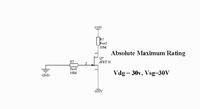fala
Full Member level 5
Hello board, I want to know if I can pass safely absolute maximum rating of Vds, Vgs, Vds of JFETs safely provided that current is limited? eg. 100V for a JFET that has 30V absolute maximum rating, but voltage will drop below 30V if a few uA current is drawn.
